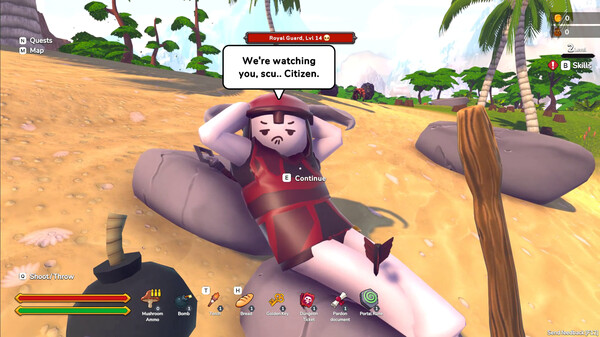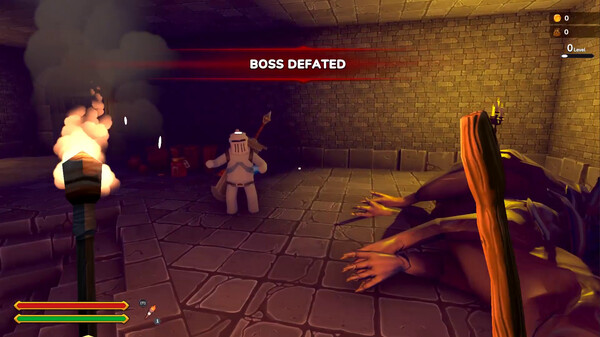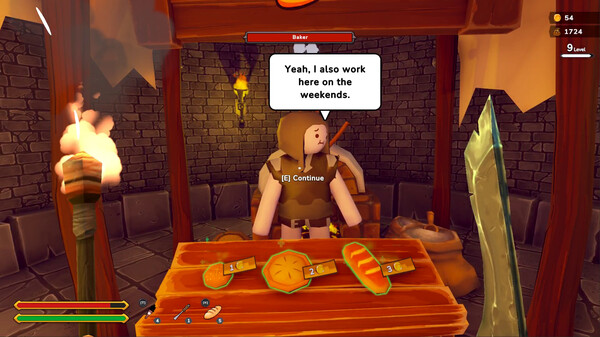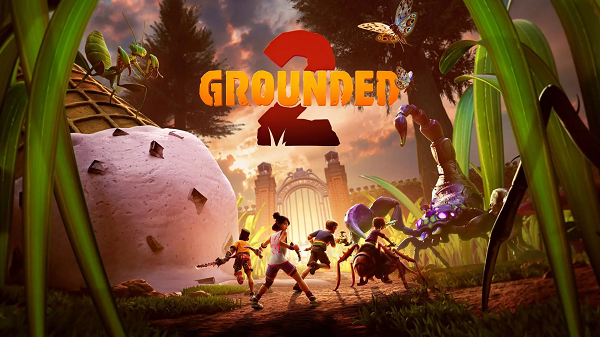Advertisement
Popular Now
'The RPG', released on Steam on August 7, 2025, by developer Dionysus Acroreites and publisher Catoptric Games, presents itself as a humorous parody of traditional role-playing games. At first glance, it appears to be a lighthearted take on classics like Skyrim or Final Fantasy, with cartoonish graphics, a blank-faced Viking protagonist, and a fantastical world ripe for exploration. However, beneath its whimsical exterior lies a bold experiment in game design: the deliberate integration of "bugs" as essential gameplay mechanics. This specific issue—the use of glitches, exploits, and intentional errors not as flaws to be patched but as features to be embraced—has sparked intense debate among players and critics alike. Far from being accidental, these elements challenge conventional RPG norms, forcing players to rethink progression, combat, and narrative. In this article, we explore this issue chronologically, from its conceptual origins to its lasting implications, revealing how 'The RPG' turns potential frustrations into innovative, if controversial, gameplay.
 The idea for incorporating bugs as mechanics in 'The RPG' stemmed from Dionysus Acroreites' frustration with polished, bug-free AAA titles. In early 2024 interviews, Acroreites described how modern RPGs had become too streamlined, losing the chaotic charm of older games plagued by glitches. He envisioned a game where bugs were not hidden but celebrated, drawing inspiration from titles like Goat Simulator, where physics exploits became the core fun. This concept was born during a solo brainstorming session, where Acroreites sketched a world where "errors" like clipping through walls or infinite item duplication were tutorialized as "ancient magic."
This approach was risky, as it inverted the industry's bug-hunting ethos. Acroreites aimed to parody RPG tropes—endless grinding, overpowered bosses—by making bugs the equalizer. For instance, the game's healing system, where players stuff bread into wounds instead of using potions, originated from a mock "bug" in a prototype where health items glitched into character models.
The idea for incorporating bugs as mechanics in 'The RPG' stemmed from Dionysus Acroreites' frustration with polished, bug-free AAA titles. In early 2024 interviews, Acroreites described how modern RPGs had become too streamlined, losing the chaotic charm of older games plagued by glitches. He envisioned a game where bugs were not hidden but celebrated, drawing inspiration from titles like Goat Simulator, where physics exploits became the core fun. This concept was born during a solo brainstorming session, where Acroreites sketched a world where "errors" like clipping through walls or infinite item duplication were tutorialized as "ancient magic."
This approach was risky, as it inverted the industry's bug-hunting ethos. Acroreites aimed to parody RPG tropes—endless grinding, overpowered bosses—by making bugs the equalizer. For instance, the game's healing system, where players stuff bread into wounds instead of using potions, originated from a mock "bug" in a prototype where health items glitched into character models.
 By late 2024, internal testing exposed the double-edged sword of bug mechanics. Playtesters discovered unintended synergies, like combining bread-healing with a duplication glitch for infinite health, which Acroreites embraced as "emergent gameplay." However, this led to debates: should all bugs be intentional, or allow true accidents?
One tester's report detailed a "softlock" where the protagonist clipped into terrain indefinitely, which was retained as a puzzle requiring map-based escape. Feedback emphasized the need for tutorials, resulting in quirky pop-ups like "Congratulations! You've discovered a feature-bug!"
This phase solidified the game's identity but raised accessibility issues. Not all players appreciated the meta-layer, viewing it as anti-RPG.
By late 2024, internal testing exposed the double-edged sword of bug mechanics. Playtesters discovered unintended synergies, like combining bread-healing with a duplication glitch for infinite health, which Acroreites embraced as "emergent gameplay." However, this led to debates: should all bugs be intentional, or allow true accidents?
One tester's report detailed a "softlock" where the protagonist clipped into terrain indefinitely, which was retained as a puzzle requiring map-based escape. Feedback emphasized the need for tutorials, resulting in quirky pop-ups like "Congratulations! You've discovered a feature-bug!"
This phase solidified the game's identity but raised accessibility issues. Not all players appreciated the meta-layer, viewing it as anti-RPG.
 On release day, August 7, 2025, 'The RPG' hit Steam with a bang—and several intentional crashes. Players encountered the bread-healing mechanic early, leading to viral memes, but real issues emerged when unintended bugs interacted with designed ones, like save file corruptions from over-exploitation.
Reviews flooded in: 70% positive on Steam, praising innovation, but negative ones decried it as "unfinished." Acroreites' launch stream addressed this, revealing all "bugs" were planned, turning confusion into appreciation for some.
The day encapsulated the issue: bugs blurred the line between design and defect, challenging player expectations.
On release day, August 7, 2025, 'The RPG' hit Steam with a bang—and several intentional crashes. Players encountered the bread-healing mechanic early, leading to viral memes, but real issues emerged when unintended bugs interacted with designed ones, like save file corruptions from over-exploitation.
Reviews flooded in: 70% positive on Steam, praising innovation, but negative ones decried it as "unfinished." Acroreites' launch stream addressed this, revealing all "bugs" were planned, turning confusion into appreciation for some.
The day encapsulated the issue: bugs blurred the line between design and defect, challenging player expectations.
 By mid-August, Acroreites released patches not to remove bugs but to enhance them—e.g., adding achievements for exploit chains. In a blog post, he defended the design as a critique of polished RPGs, citing games like No Man's Sky's redemption arc.
This sparked ethics debates: is it manipulative to sell "broken" mechanics? Acroreites argued it empowers players, but critics called it gimmicky.
Interventions balanced the ecosystem, preventing total chaos.
By mid-August, Acroreites released patches not to remove bugs but to enhance them—e.g., adding achievements for exploit chains. In a blog post, he defended the design as a critique of polished RPGs, citing games like No Man's Sky's redemption arc.
This sparked ethics debates: is it manipulative to sell "broken" mechanics? Acroreites argued it empowers players, but critics called it gimmicky.
Interventions balanced the ecosystem, preventing total chaos.
1. The Conceptual Origins: Planting the Seeds of Subversion (Pre-Development Phase)
 The idea for incorporating bugs as mechanics in 'The RPG' stemmed from Dionysus Acroreites' frustration with polished, bug-free AAA titles. In early 2024 interviews, Acroreites described how modern RPGs had become too streamlined, losing the chaotic charm of older games plagued by glitches. He envisioned a game where bugs were not hidden but celebrated, drawing inspiration from titles like Goat Simulator, where physics exploits became the core fun. This concept was born during a solo brainstorming session, where Acroreites sketched a world where "errors" like clipping through walls or infinite item duplication were tutorialized as "ancient magic."
This approach was risky, as it inverted the industry's bug-hunting ethos. Acroreites aimed to parody RPG tropes—endless grinding, overpowered bosses—by making bugs the equalizer. For instance, the game's healing system, where players stuff bread into wounds instead of using potions, originated from a mock "bug" in a prototype where health items glitched into character models.
The idea for incorporating bugs as mechanics in 'The RPG' stemmed from Dionysus Acroreites' frustration with polished, bug-free AAA titles. In early 2024 interviews, Acroreites described how modern RPGs had become too streamlined, losing the chaotic charm of older games plagued by glitches. He envisioned a game where bugs were not hidden but celebrated, drawing inspiration from titles like Goat Simulator, where physics exploits became the core fun. This concept was born during a solo brainstorming session, where Acroreites sketched a world where "errors" like clipping through walls or infinite item duplication were tutorialized as "ancient magic."
This approach was risky, as it inverted the industry's bug-hunting ethos. Acroreites aimed to parody RPG tropes—endless grinding, overpowered bosses—by making bugs the equalizer. For instance, the game's healing system, where players stuff bread into wounds instead of using potions, originated from a mock "bug" in a prototype where health items glitched into character models.
Early Inspirations from Gaming History
Acoreites cited classics like The Elder Scrolls series, where bugs like backwards flying in Morrowind became community legends. He wanted 'The RPG' to formalize this, turning accidental discoveries into deliberate design.Key Influences:
- Skyrim's giant-launching glitch: Inspired aerial combat exploits.
- Final Fantasy's missingno-like errors: Shaped item duplication mechanics.
- Undertale's meta-subversion: Influenced narrative-breaking bugs.
2. Prototyping the Chaos: Building a Bug-Ridden Foundation (Early Development, 2024)
During the prototyping phase in mid-2024, Acroreites focused on engineering "controlled chaos." The game's engine, built on Unity, was tweaked to simulate bugs reliably—such as random teleportation or enemy AI failures—without crashing the game. One core mechanic, the "Dragon Skip," allows players to defeat the final boss early via a deliberate collision glitch, subverting the linear quest structure typical of RPGs. This phase revealed technical hurdles: ensuring bugs were fun rather than frustrating required extensive iteration. Testers reported mixed feelings; some loved the freedom, while others felt it undermined skill-based progression. Acroreites adjusted by adding in-game lore explaining bugs as "curses from the glitch gods," blending humor with mechanics. The prototyping also highlighted ethical concerns. Was it fair to market a game with intentional flaws? Acroreites argued it was a commentary on perfectionism in gaming, but early leaks on forums sparked accusations of laziness.Technical Implementation of Bugs
Unity scripts were modified to trigger "bugs" based on player actions, like overstacking inventory to cause item explosions.Challenges Faced:
- Balancing exploit frequency to avoid game-breaking loops.
- Ensuring cross-platform consistency (PC focus, with plans for consoles).
- Integrating bugs into narrative without alienating casual players.
3. Internal Testing Turmoil: Feedback Loops and Refinements (Late 2024)
 By late 2024, internal testing exposed the double-edged sword of bug mechanics. Playtesters discovered unintended synergies, like combining bread-healing with a duplication glitch for infinite health, which Acroreites embraced as "emergent gameplay." However, this led to debates: should all bugs be intentional, or allow true accidents?
One tester's report detailed a "softlock" where the protagonist clipped into terrain indefinitely, which was retained as a puzzle requiring map-based escape. Feedback emphasized the need for tutorials, resulting in quirky pop-ups like "Congratulations! You've discovered a feature-bug!"
This phase solidified the game's identity but raised accessibility issues. Not all players appreciated the meta-layer, viewing it as anti-RPG.
By late 2024, internal testing exposed the double-edged sword of bug mechanics. Playtesters discovered unintended synergies, like combining bread-healing with a duplication glitch for infinite health, which Acroreites embraced as "emergent gameplay." However, this led to debates: should all bugs be intentional, or allow true accidents?
One tester's report detailed a "softlock" where the protagonist clipped into terrain indefinitely, which was retained as a puzzle requiring map-based escape. Feedback emphasized the need for tutorials, resulting in quirky pop-ups like "Congratulations! You've discovered a feature-bug!"
This phase solidified the game's identity but raised accessibility issues. Not all players appreciated the meta-layer, viewing it as anti-RPG.
Refining the Bug Ecosystem
Acoreites categorized bugs: cosmetic (funny animations), mechanical (combat exploits), and narrative (plot-skipping glitches).Tester Insights:
- 60% enjoyed bug freedom.
- 30% found it confusing.
- 10% reported actual crashes, fixed pre-release.
4. Beta Release Backlash: First Public Encounters (Early 2025)
The closed beta in January 2025 marked the first public exposure, eliciting polarized reactions. On Steam forums, players praised the Dragon Skip as revolutionary, allowing non-linear play in a genre often criticized for railroading. However, complaints surged about "unfair" mechanics, like enemies despawning mid-fight due to AI "bugs." Social media buzzed with clips of absurd exploits, boosting hype but also drawing criticism from traditional RPG fans who felt it mocked the genre. Acroreites responded in dev logs, explaining bugs as satire on buggy launches like Cyberpunk 2077. This period highlighted community division: speedrunners loved it, while completionists struggled with unpredictable progression.Community Feedback Analysis
Beta surveys showed high engagement but low satisfaction for linear players.Common Complaints:
- Inconsistent difficulty due to exploits.
- Lack of "real" achievements.
- Desire for a "bug-free" mode (later added as DLC).
5. Launch Day Anomalies: Immediate Post-Release Chaos (August 7, 2025)
 On release day, August 7, 2025, 'The RPG' hit Steam with a bang—and several intentional crashes. Players encountered the bread-healing mechanic early, leading to viral memes, but real issues emerged when unintended bugs interacted with designed ones, like save file corruptions from over-exploitation.
Reviews flooded in: 70% positive on Steam, praising innovation, but negative ones decried it as "unfinished." Acroreites' launch stream addressed this, revealing all "bugs" were planned, turning confusion into appreciation for some.
The day encapsulated the issue: bugs blurred the line between design and defect, challenging player expectations.
On release day, August 7, 2025, 'The RPG' hit Steam with a bang—and several intentional crashes. Players encountered the bread-healing mechanic early, leading to viral memes, but real issues emerged when unintended bugs interacted with designed ones, like save file corruptions from over-exploitation.
Reviews flooded in: 70% positive on Steam, praising innovation, but negative ones decried it as "unfinished." Acroreites' launch stream addressed this, revealing all "bugs" were planned, turning confusion into appreciation for some.
The day encapsulated the issue: bugs blurred the line between design and defect, challenging player expectations.
Release Metrics
Peak concurrent players: 5,000; mixed reviews initially.Launch Highlights:
- Viral Dragon Skip videos.
- Forum threads debating "true bugs" vs. features.
- Hotfix for actual crashes.
6. Player Discoveries and Meta-Game Evolution (First Week Post-Launch, August 8-14, 2025)
In the first week, communities on Reddit and X dissected bugs, creating wikis for exploits like infinite gold via vendor glitches. This meta-game emerged, where mastering bugs became the real progression, subverting RPG grinding. Some players reported "bug chains"—linking glitches for god-mode runs—fostering creativity. However, this alienated newcomers, who saw it as paywall-like complexity without guidance. The evolution showed bugs fostering emergent narratives, like player-shared "glitch tales."Emergent Strategies
Speedruns under 10 minutes via skips.Popular Exploits:
- Wall-clipping for shortcuts.
- AI manipulation for easy wins.
- Narrative forks via dialogue bugs.
7. Developer Interventions: Patches and Philosophy (Mid-August 2025)
 By mid-August, Acroreites released patches not to remove bugs but to enhance them—e.g., adding achievements for exploit chains. In a blog post, he defended the design as a critique of polished RPGs, citing games like No Man's Sky's redemption arc.
This sparked ethics debates: is it manipulative to sell "broken" mechanics? Acroreites argued it empowers players, but critics called it gimmicky.
Interventions balanced the ecosystem, preventing total chaos.
By mid-August, Acroreites released patches not to remove bugs but to enhance them—e.g., adding achievements for exploit chains. In a blog post, he defended the design as a critique of polished RPGs, citing games like No Man's Sky's redemption arc.
This sparked ethics debates: is it manipulative to sell "broken" mechanics? Acroreites argued it empowers players, but critics called it gimmicky.
Interventions balanced the ecosystem, preventing total chaos.
Patch Notes Breakdown
Version 1.1: Bug enhancements, no removals.Developer Stance:
- Bugs as empowerment.
- Community input for new "features."
- Plans for mod support.
8. Comparative Analysis: 'The RPG' vs. Industry Standards (Late 2025 Projections)
Compared to bug-plagued launches like Starfield (2023) or Wuchang: Fallen Feathers (2025), 'The RPG' inverts the narrative—bugs are the selling point. Unlike Monster Hunter Wilds' performance issues leading to negative reviews, here they drive engagement. This positions 'The RPG' as a niche disruptor, akin to Untitled Goose Game's chaos but in RPG form. Projections suggest it influences indie devs toward experimental design.Parallels and Contrasts
Vs. Skyrim: Accidental bugs vs. intentional.Industry Impacts:
- Inspires "bug-positive" games.
- Challenges QA norms.
- Boosts parody subgenre.
9. Community Long-Term Effects: Cult Following and Criticisms (Ongoing, 2025+)
A cult following emerged, with fan mods adding more bugs, extending replayability. Criticisms persist: accessibility barriers for non-meta players, potential for frustration burnout. Long-term, it fosters discussions on game imperfection, influencing player tolerance for flaws in other titles. The community effects highlight bugs as social glue, building shared experiences.Sustained Engagement
Forums active with bug-sharing.Pros and Cons:
- Pros: Innovation, humor.
- Cons: Frustration, divisiveness.
- Future: Expansions with new bugs.
10. Future Implications: Redefining RPG Design (Beyond 2025)
Looking ahead, 'The RPG's bug mechanics could redefine RPGs, encouraging designs that embrace imperfection. If successful, it paves the way for sequels or copycats, shifting industry focus from polish to playfulness. However, risks include alienating mainstream audiences, potentially limiting growth. Acroreites hints at updates integrating player-created bugs, democratizing design. Ultimately, this issue positions 'The RPG' as a milestone in subversive gaming.Vision for Sequels
'The RPG 2': Multiplayer bug-sharing.Broader Lessons:
- Embrace flaws.
- Player agency over perfection.
- Satire as innovation.

















